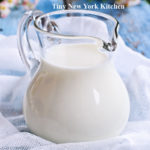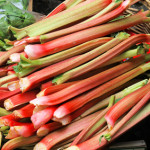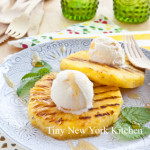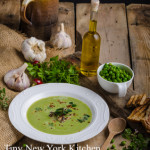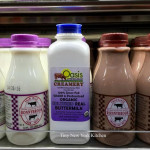Buttermilk is a fermented dairy drink that was traditionally the liquid left behind after churning butter out of cultured cream. Today, most modern buttermilk is cultured. Cultured buttermilk was first commercially introduced in the US in the 1920s. Commercially produced buttermilk is milk that has been pasteurized, homogenized, and then inoculated with a culture of Lactococcus lactis to simulate the naturally occurring bacteria in the old-fashioned buttermilk. The tartness of cultured buttermilk is primarily due to lactic acid produced by lactic acid bacteria while fermenting lactose, the primary sugar in milk.
Condensed buttermilk and dried buttermilk are very important in the food industry. Liquid buttermilk is used primarily in the commercial preparation of baked goods and cheese. Buttermilk solids are used in ice cream manufacturing as well as being added to pancake mixes to make buttermilk pancakes.
Buttermilk reacts with the baking soda and powder to give quick breads their rise and tender crumb. The reaction is best at the beginning, you’ll want to get the loaf in the oven right after mixing the wet and dry ingredients. Buttermilk can also be used in marinating meats, especially chicken and pork, because the lactic acid helps to tenderize, retain moisture, and allows added flavors to permeate the meats.
©Tiny New York Kitchen © 2021 All Rights Reserved
Going out for dinner on Valentine’s Day is a risky affair. Even the best restaurants can have “overload difficulties” on such a busy night where couples have expectations of restaurant perfection. A better way to manage expectations is to take control of them yourself. Food is a language of love. You know what you like and what your loved one likes. No need to worry about cheesy love songs or a perfumed soaked lady sitting next to you. Nothing says I love you more than taking the time to make a special meal for the person you love. Visit the local farmers’ market, butcher, or seafood shop to buy their favorite seasonal ingredients. Come up with a meal that celebrates love. Turn off the lights, fire up all the candles and put on your favorite music.
Keep it easy and made make it special. Plan out the meal from beginning to end to get organized and make sure you have a solid menu. If you’re not a seasoned cook make sure to keep it simple and I recommend not trying to make complicated dishes that you’ve never made before. Make it easy with three courses. Begin with a beautiful cheese plate. Embrace easy, big impact dishes. Start off with prosciutto-wrapped scallops finished with a squeeze of lemon. Warm things up with braised short ribs or steaks finished off with butter and herbs. Keep desserts simple, but sweet. Decorate bakery cakes with fresh fruit or edible flowers or warm up slices of pie and top with caramel sauce and a gourmet ice cream or try your hand at an easy dessert of chocolate pots de crème. Don’t forget that nice bottle of wine or champagne.
“Work With What You Got!”
©Tiny New York Kitchen © 2018 All Rights Reserved
Grilled pineapple is so very versatile because you can use it for savory or sweet, hot or cold dishes. Grill over indirect heat and the sugars in the pineapple concentrate bringing out a sweet and meaty fruit that is ideal for endless summer recipes.
6 Ways To Use Grilled Pineapple
Slice and serve with grilled pork or fish.
Cut into chunks and toss with salt and lime juice for a smoky fruit salad.
Muddle and use as the base for a sweet-savory cocktail.
Dice and mix with chopped cilantro and chiles for salsa.
Purée and spoon over vanilla ice cream or good Greek yogurt.
Top with ice cream or sorbet.
“Work With What You Got!”
© Victoria Hart Glavin Tiny New York Kitchen © 2017 All Rights Reserved
Just a few fresh berries add color and nutrients to a salad, cocktail, or mocktail.
Stock up on fresh berries, wash and freeze them in a single layer on a sheet pan. Then transfer to a freezer bag for future smoothies and baked goods.
Add a handful of berries to a parfait, with yogurt for breakfast or ice cream for dessert.
Gently fold berries into muffin and pancake batter. Cook a big batch and freeze some for easy breakfasts later.
Make into a savory salsa and serve as a dip or over grilled chicken or wild-caught salmon.
“Work With What You Got!”
© Victoria Hart Glavin Tiny New York Kitchen © 2017 All Rights Reserved
I grew up in the Midwest where it was considered a mortal sin to waste food. The motto was “waste nothing and make the most of every ingredient.” Here are some ways for you and your family to make the most of ingredients that otherwise may make their way into the trash bin.
Stewed Fruit does double duty as a topping for pancakes, waffles and ice cream while giving you a serving of fruit. Get started with apples and dried fruits.
Super Stems. Don’t waste the nutrients in stems of greens like collards and kale, or vegetables like broccoli and cauliflower. Use them in longer cooking soups and stews.
Save The Soft. Baked desserts are a great way to use up slightly overripe fruit.
Use It, Don’t Lose It. When you by a special ingredient for a recipe, don’t waste what’s left. Get creative and add them to some of your favorite recipes.
Make Soup with leftovers. Vegetables, grains, and meats make wonderful soups. If you don’t have time to make soup right away, freeze the leftovers until you have a good cooking day. Don’t forget to label and date what you’re freezing for later.
“Work With What You Got!”
© Victoria Hart Glavin Tiny New York Kitchen © 2017 All Rights Reserved
The Weather Is Perfect And, Hallelujah, The Creamery Is Open For The Season! Perfect Weather Equals Creamery Ice Cream. Well, Truth Be Told I’m Always Up For Ice Cream. Life Just Couldn’t Be Any Better!
“Work With What You Got!”
© Victoria Hart Glavin Tiny New York Kitchen © 2016 All Rights Reserved
In the old days, buttermilk was what was left in the butter churn. Nowadays, it’s manufactured with healthy bacteria much like yogurt. Buttermilk is made with very little fat or none at all. Either way, it adds a nice fresh tang and texture to baked goods. In the summer it’s nice to purée peaches with a little sugar, add buttermilk, and freeze in an ice cream maker to create a healthy low-fat homemade version of frozen yogurt. Buttermilk will keep for several weeks in the coldest part of your refrigerator.
“Work With What You Got!”
© Victoria Hart Glavin Tiny New York Kitchen © 2016 All Rights Reserved

